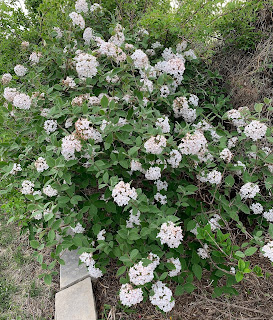 Most gardeners, ProfessorRoush included, labor under the delusion that we choose our plants, the plants we value enough to care for, but, truth be told, it is often the plants that choose us. My list of the plants that co-inhabit our garden with me contains three main subcategories; the very, very, very long list of plants that I purchased that have subsequently perished from the prairie, the surprisingly short list plants I purchased that still survive in the garden, and the unintentionally long list of plants that chose my garden as adequate shelter for their own purposes. I've spoken before of the native plants, like Asclepias tuberosa, or the Salvia azurea that I allow to grow as they desire in any bed of the garden. I've also written about some plants that insist on growing everywhere here, such as Ambrosia artemisiifolia, despite my constant efforts to eliminate them.
Most gardeners, ProfessorRoush included, labor under the delusion that we choose our plants, the plants we value enough to care for, but, truth be told, it is often the plants that choose us. My list of the plants that co-inhabit our garden with me contains three main subcategories; the very, very, very long list of plants that I purchased that have subsequently perished from the prairie, the surprisingly short list plants I purchased that still survive in the garden, and the unintentionally long list of plants that chose my garden as adequate shelter for their own purposes. I've spoken before of the native plants, like Asclepias tuberosa, or the Salvia azurea that I allow to grow as they desire in any bed of the garden. I've also written about some plants that insist on growing everywhere here, such as Ambrosia artemisiifolia, despite my constant efforts to eliminate them.There is a fourth category, however of gardening troubles that we purchase, sometimes intentionally and sometimes by accident, and come to regret. Such an accidental hitchhiker in my garden is illustrated by what I think is a type of hops vine pictured above, photo taken just today. This vine has been a constant nuisance in this one spot in my garden for the twenty years we've lived here. About every two weeks, I have to search out and destroy the many sprouts of this fast-growing vine, lest it overwhelm every other plant in the area. I've never grown it intentionally, but I can trace its arrival to a load of "good" soil that we had brought in to provide a decent border around the stamped concrete patio in the back when we built the house. Interestingly there were 3 actual truck loads delivered to form this border, but the only area that grows the presumed hops vine was from a single truckload. If asked, I can attest that the seeds of these vines survive and germinate at least 20 years after being deposited. The only remaining question is whether the hops seeds will ever cease to germinate or whether I leave this Earth first and am beyond caring about it.
 |
| Aralia cordata, K-State Gardens |


















































